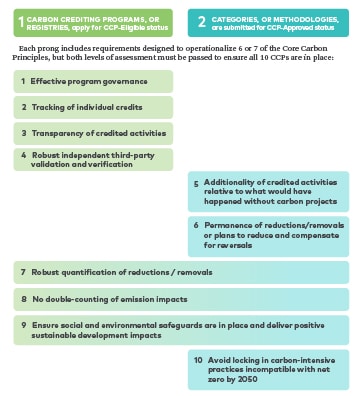As more companies commit to taking ambitious climate action, industry guidance has increasingly coalesced around one central principle: emission reductions, both within companies’ operations and their value chains, must be at the heart of any robust climate strategy. At the same time, high-quality carbon credits represent an increasingly popular tool that companies can use to mitigate climate change beyond the reach of their own value chains and help address their emissions that can’t yet be abated.
The heightened visibility of the voluntary carbon market has led to criticism that it is difficult for organizations and observers to quickly or clearly identify high quality carbon credits. The Integrity Council for the Voluntary Carbon Market (ICVCM), an industry working group seeking to establish a global threshold for credit quality, aims to address this major area of uncertainty. In July 2023, ICVCM released its complete carbon credit quality guidance, which outlines a set of quality principles and an assessment framework to determine which carbon credits can achieve the newly introduced Core Carbon Principle-Approved (or CCP-Approved) label.
What’s in the July 2023 ICVCM framework?
The July 2023 ICVCM framework outlines a two-pronged process for ICVCM to assess carbon credits and apply their stamp of approval (the “CCP-Approved” label). Under one prong, standards bodies (also known as registries or carbon-crediting programs) must apply to ICVCM to ensure their governance practices, basic infrastructure for accurately measuring emissions impact, and safeguards to support the UN Sustainable Development Goals meet ICVCM’s criteria. If this application is approved, ICVCM will grant the standards body “CCP-Eligible” recognition. Under the second prong, standards bodies can submit specific carbon project methodologies for ICVCM assessment and approval at the “category-level.” Once approval is secured under both the program and category assessment prongs, the standards body can label carbon credits issued under its approved project categories as “CCP-Approved.”
The “CCP-Approved” label will ideally assist carbon credit purchasers in navigating the market by transparently indicating which types of credits sufficiently and consistently meet ICVCM’s elevated quality standard.
The new category-level assessment framework lays out new requirements for six of the ten Core Carbon Principles, including those related to emissions impact and sustainable development (see Figure 1).


Major takeaways from the category-level assessment framework
Even with ICVCM’s recent completion of its full assessment framework, it is still unclear how many and which credit types will be able to pass ICVCM’s quality bar. While some new requirements already seem likely to make certain methodologies ineligible for CCP-approval, other parts of the guidance leave significant room for interpretation. For example, project types that do not use ICVCM’s recommended approaches to prove additionality can submit an explanation for how their own approach satisfies ICVCM’s broader additionality criteria. As such, category approval decisions are difficult to predict, and will fall largely to the discretion of the ICVCM Category-level working groups.
Key takeaways on how certain project types are likely to be received by ICVCM working groups are summarized below.
- Project types eligible for use under the Carbon Offsetting and Reduction Scheme for International Aviation (CORSIA) will meet many (but not all) of the ICVCM requirements, as ICVCM references the CORSIA principles extensively as the foundation of its guidance. Conversely, project types ineligible under CORSIA may struggle to gain ICVCM approval. This alignment indicates a positive trend towards standardization of credit quality thresholds for the voluntary carbon market.
- ICVCM’s guidance explicitly identifies project types that have faced additionality challenges in the past, implying that ICVCM may not easily approve them. These project types include renewable energy, fuel switching, energy efficiency, and HFC23 reduction projects. However, ICVCM also states that registries’ additionality-based eligibility restrictions on their methodologies will be taken into consideration as part of ICVCM’s category-level review, implying that (for example) application of a renewable energy project methodology might gain approval only in Least Developed Countries.
- ICVCM also identifies and applies unique requirements to nature-based project types that face substantial non-permanence (that is, reversal-related) risks. Some project types in this category include avoided conversion of forestland and grasslands, restoration of forestland and wetlands, and some agricultural project types (e.g., agroforestry and agricultural soil carbon sequestration). These projects must continue monitoring, reporting, and (if necessary) compensating for reversals for at least 40 years, meaning that nature-based project methodologies with monitoring periods shorter than 40 years should not be expected to gain ICVCM approval.
- In addition, ICVCM specifies some newer project types that must assess and manage their reversal risks to gain approval, including biochar, carbon capture with storage, enhanced weathering, and CO2 storage in concrete. While most of these project types do not yet have formal methodologies under major registries, and therefore may not be eligible for ICVCM approval in the near-term, this ICVCM requirement could shape the development of these methodologies to account for long-term reversal risks.
- ICVCM outlines a final set of project types that are ineligible to receive CCP-Approval because they “lock in” greenhouse gas emissions or carbon-intensive technologies, making them incompatible with global net zero goals. These include projects storing carbon via enhanced oil recovery, projects involving any unabated fossil fuel-based electricity generation (with exceptions for certain natural gas projects that are part of national low-carbon energy transition plans), and projects focused on road transport using solely fossil fuel-powered engines.
- Finally, ICVCM states it will await Verra’s forthcoming release of an updated REDD+ methodology (a consolidated version of five separate methodologies for reducing emissions from unplanned deforestation in developing countries) to assess this project category. This implies that credits from reduced deforestation projects that have not transitioned to Verra’s forthcoming consolidated methodologies (for planned and unplanned deforestation) are unlikely to gain CCP-Approval. Whether the new Verra reduced deforestation methodologies gain CCP-Approval will likely depend on whether ICVCM considers them to show sufficient improvement on the areas that led to their predecessors’ failure to gain approval under CORSIA. An example of one such area is insufficient assurance of additionality.
What does the complete ICVCM guidance mean for organizations looking to procure carbon credits?
The impact of the ICVCM guidance on the market will depend on how widely it is adopted and who its early adopters are
For the ICVCM framework to become an industry standard, major registries must first bolster the initiative by applying for approval, thus contributing to an adequate supply of CCP-Approved credits on the market. If reputable NGOs and thought leaders shaping other prominent pieces of guidance for corporate climate action (e.g., WWF, WRI, University of Oxford, etc.) also endorse this framework, this will help clearly signal to buyers that they should prioritize procurement of CCP-Approved credits.
Thus far, ICVCM’s complete framework has generally been received positively by carbon credit rating agencies and some major registries, such as Verra and Gold Standard. In addition, the ICVCM was recently endorsed by prominent supply-side guidance on credible carbon credit claims from the Voluntary Carbon Markets Integrity Initiative (VCMI). Per VCMI’s guidance, organizations wishing to make credible, approved claims using carbon credits must procure credits that have been approved under ICVCM’s framework.
However, whether ICVCM’s guidance will ultimately be widely adopted by registries and buyers remains difficult to predict, as the stringency with which ICVCM’s requirements will be applied to credit categories remains unknown.
If ICVCM’s guidance is widely adopted, organizations can expect to conduct less category-level due diligence, but must continue to perform project-level assessments
If the ICVCM framework becomes a global standard, organizations can feel more confident that a given credit within a CCP-Approved category will represent one additional, durable ton of reduced or removed carbon dioxide-equivalent. This standardization may allow prospective carbon credit offtakers to conduct less due diligence at the project category level, allowing greater focus on a specific developer’s experience and approach to implementation.
While CCP-Approval may indicate integrity of a given methodology, significant quality variations will remain at the project level. This means that some CCP-Approved credits may still bear quality risks, while some credits not tagged as CCP-Approved may still deliver high-quality mitigation outcomes. Therefore,supplementary project-level due diligence will still be important to identify and address aspects of project implementation that cannot be covered by category-level criteria, such as a developer’s history of on-time and in-full delivery, reputational risk associated with a partner’s past actions or location of the project, or weak points of the methodology that may have passed ICVCM muster but should still be given extra attention during implementation.
It is too soon to say how the ICVCM framework may impact credit pricing, but forecasts generally expect the prices of high quality credits to increase
In recent years, prominent forecasts of voluntary carbon market dynamics have consistently projected prices of higher-quality credits to increase more significantly than other credits on the market. If the ICVCM guidance is widely adopted, it will split the market into groups of credits that are of CCP-Approved and non-CCP-Approved. This may inspire more confidence and demand among corporate buyers who were previously concerned with the reputational risk of inadvertently procuring low-quality credits. Therefore, while it remains difficult to predict ICVCM’s direct impact on market dynamics, buyers should look out for increasing prices for certain high-quality project types, especially if widespread ICVCM adoption results in an even more distinct bifurcation in pricing between high- and low-quality credits.
Many emerging carbon removal technologies will not be able to secure ICVCM approval in the near-term, but organizations can still support them with investment-based claims
Many nascent carbon removal project activities (e.g., direct air capture with carbon storage; enhanced weathering) do not yet have approved methodologies under major registries. Therefore, these project types are not likely to achieve ICVCM approval in the near-term. However, scaling these emerging technologies will be vital to meeting long term climate targets, and the lack of a “CCP-Approved” tag for these projects does not necessarily correspond with a low level of quality. Companies can best support these emerging project types while minimizing reputational risk by focusing their claims on the support (e.g., finance) they have contributed to greater emission reductions and removals, as opposed to matching reduction or removal credits with their own unabated emissions and claiming these emissions have been “neutralized” or “offset.” Contributing in this manner to early-stage project types has the added benefit of scaling technologies that could help an organization decarbonize its own operations in the future, but that are not feasible to apply at scale today.
What’s next for the ICVCM framework?
With the two-pronged assessment framework complete, ICVCM will begin assessing applications from carbon credit standards bodies as well as project methodologies against its quality criteria. ICVCM has announced that it will fast-track certain methodologies that are very likely to be approved, while also prioritizing credit categories with the largest market shares.
With the release of its completed guidance, ICVCM also highlighted the need for continuous improvement, announcing areas for further consideration and plans to release an updated framework by the end of 2025. Key focus areas ICVCM has flagged for improvement include: greater permanence requirements; the role of digital monitoring, reporting, and verification; simplified approaches for small projects; and greater cooperation with Indigenous Peoples and Local Communities (IPs & LCs).


Figure 2
The full slate of ICVCM guidance is an important step forward in creating a global quality threshold for the voluntary carbon market. While it remains to be seen how quickly and widely this new standard will be adopted, ICVCM aims to set a critical baseline for quality while committing to improving standards over time as best practices evolve. Despite lingering uncertainty on how flexibly ICVCM will apply its guidance, companies should feel confident in entering the carbon market today as quality standards continue to strengthen. It is vital that companies leverage every tool at their disposal now to prevent the worst impacts of climate change, including actions to mitigate emissions beyond their value chain and scale technologies that will help reach in-house decarbonization targets.
If you have any questions about how the ICVCM guidance or other carbon market evolutions may impact your climate strategy, please reach out.
Read part one of our ICVCM guidance series, “Balancing quality with quantity in the voluntary carbon market“.
Tory Hoffmeister is a Manager on 3Degrees’ Energy and Climate Practice consulting team
Emma Friedl is a Consultant on 3Degrees’ Energy and Climate Practice consulting team



